Sabah may not have a lot of tall building, but we have many long building (longhouse). Though other Sabah native tribes such as Murut and Dusun Lotud also build longhouse, larger number of Rungus people, a sub-ethnic of Kadazandusun (largest indigenous group of Sabah) with a population of 80,000*, still practise the traditional lifestyle of living in a longhouse today. In 1930s, there was a Rungus longhouse stretched as long as 5 Kilometers!**
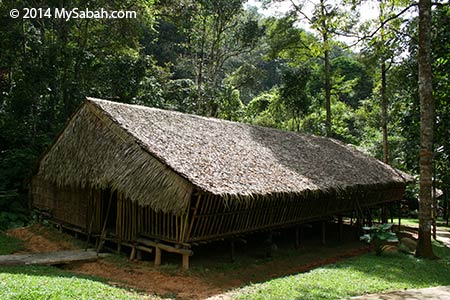
Pic: a traditional Rungus longhouse
A Rungus longhouse (known as Vinataang in local language) is made up of 7 to 15 or more family apartments co-joined laterally. Most residents in a longhouse are relatives among themselves. If new family is added, the owner would extend the longhouse at one end. A Rungus village consists of 1 or more longhouses (usually 5 or 6). Longhouse is common in northern part of Sabah, from Matunggong, Kudat, Kota Marudu to Pitas.
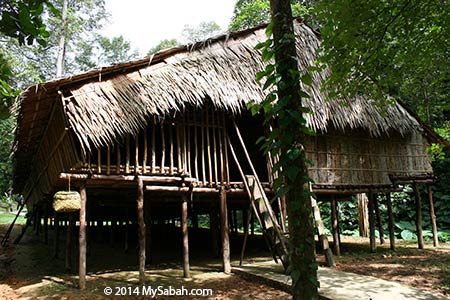
Traditional longhouse is built from wood, bamboo and atap (palm leaves). To avoid flood and wildlife such as snake, the house is lift off the ground by stilts made of hard wood such as bogil, belian ironwood, mangrove wood and manzalangan**. In old day, they also raised pigs under the longhouse. The roof is dry palm leaves of sago or nipah, and needs to be replaced every 3 to 5 years.
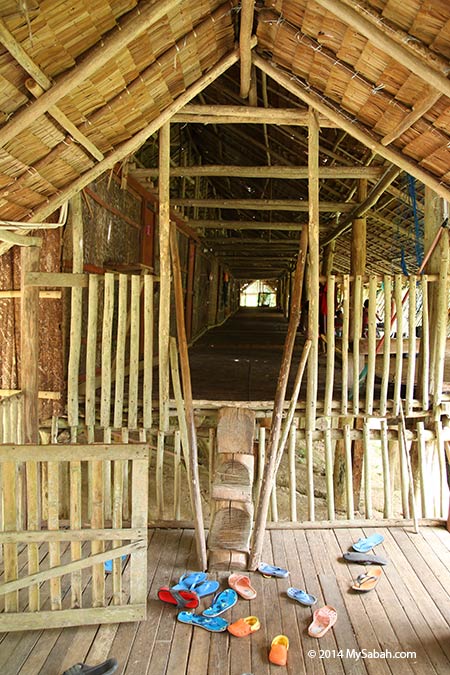
Pic: entry ladder to longhouse
There are many taboos about longhouse. For example, the site of a new longhouse is chosen based on signs such as dream, animals, weather and human behaviour. If a python (which symbolise death in local belief) appears at the construction site, they would not build the longhouse there. In contrast, tortoise is an auspicious sign. Guest who enters apartment under construction, or leaving the house without informing the host will bring bad luck. The wood of toodopon and puvok trees can’t be used in making house, as they will bring illness, disaster or bad luck. Nevertheless, after many Rungus converted to Christian, they may not strictly uphold these belief now.
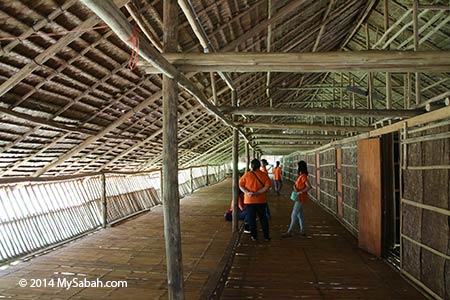
Pic: the long and wide corridor of longhouse. Rungus longhouse is divided into two distinct areas, the apad or common gallery (left), and Ongkob or compartment area (right). Apad is an open area for work and leisure activities such as rice pounding and celebration.
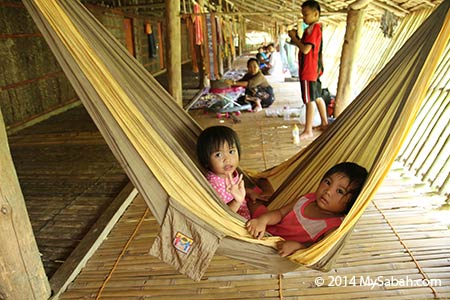
The raised platform (tingkang) of apad is a general working area and sleeping area for older boys.
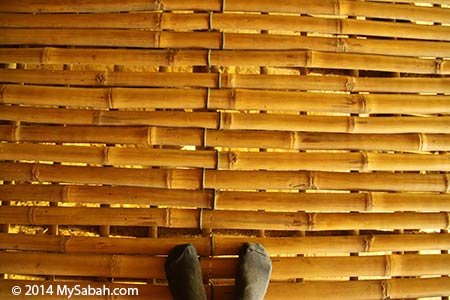
Pic: flooring made of split bamboo or nibung.
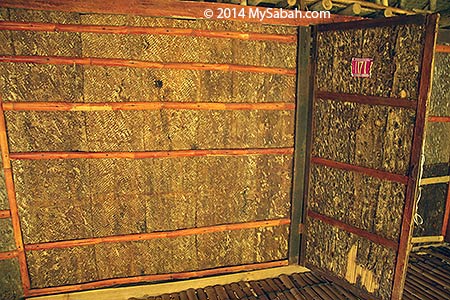
Pic: The wall is created from the bark of manzalangan or tarap tree (Artocarpus odoratissimus). There are some holes on the wall if you want to peek what your neighbour is busy on lol.
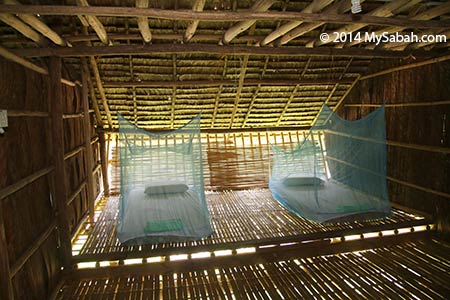
Pic: I was staying in Maranjak Longhouse for a night and this is my bedroom in longhouse. They have electric bulb to light up the room and corridor. The mosquito net can keep hungry mosquito at bay. There were far fewer mosquitoes than I thought because the longhouse is near to the forest. The wall is so thin that I can hear clearly what the girls in next room talking. During bedtime, I can almost hear the girl breathing, as if she was sleeping on my bed. Luckily she didn’t snore (but I did, HAHAHA). The longhouse is a bit warm in daytime, but at night it is quite cooling. In my dream, I heard two geckos fighting near my bed.
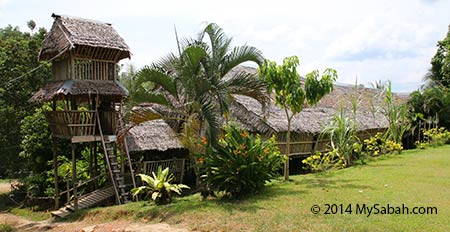
During my stay in Maranjak Longhouse, I took a closer look at the Rungus longhouse.
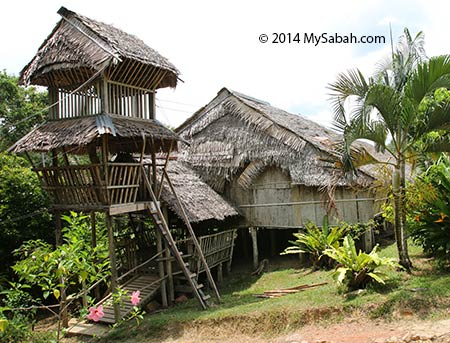
Then I saw a tower at other end of the longhouse. At first I think it’s for the guard. Then they tell me that that tower is called Rorizan, the place to keep the most beautiful girl in the longhouse.
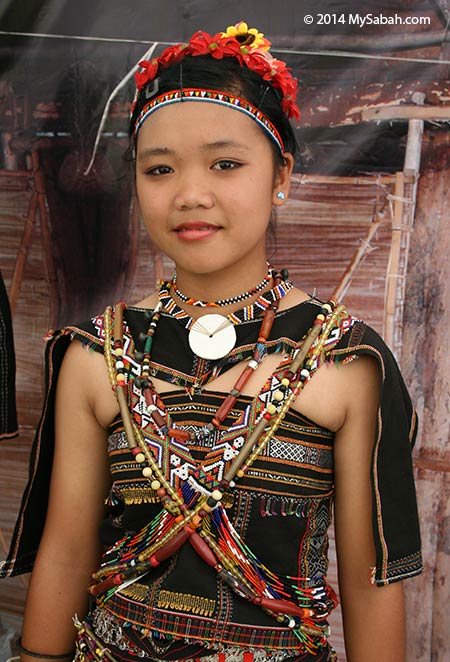
In case you fall in love with the girl in Rorizan… FYI, to marry a Rungus lady, big muscle is not enough. You also need brain and patience.
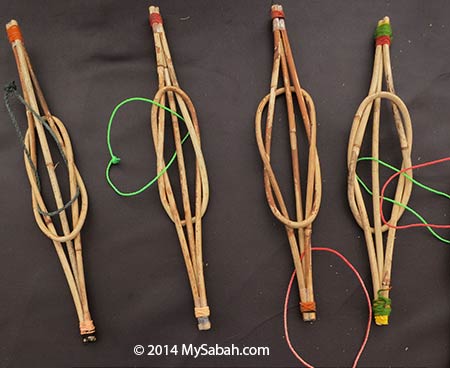
Because, you will be tested by Inuog Dazang (Teka Teki Puteri) puzzle, to free the rope from interlocked rattan knots, without cutting it. If you succeed, you can marry the girl without paying any bride price. You can try until you cry but not getting it. Don’t worry, I already have the formula for you. You can buy me some beers if you win a Rungus bride.
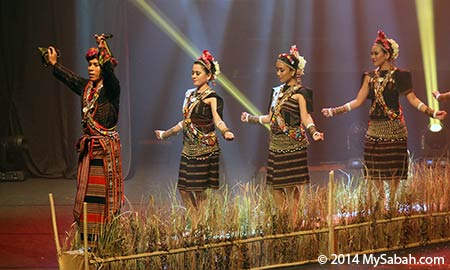
Pic: you may have seen the photo of Rungus people dancing Mongigol Sumandai (a welcoming dance mimic the movement of dragon and the male being the head of dragon) and think that Rungus man can have many wives. Rungus marriage is monogamy. Sex before marriage is strictly prohibited, as Rungus people believe this will bring sickness and death to their village. Besides, girls are kept separate from boys except at work. I’m talking about the old time.
Modern Longhouses
Nowadays each Rungus family prefers to have their own house. Also, it’s rare to see thatched-roof Rungus longhouse as corrugated zinc is preferred roofing material. If you see an authentic longhouse, very likely it is built for the tourists. 😀
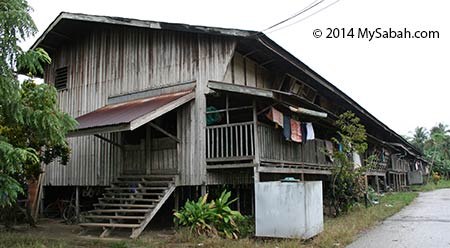
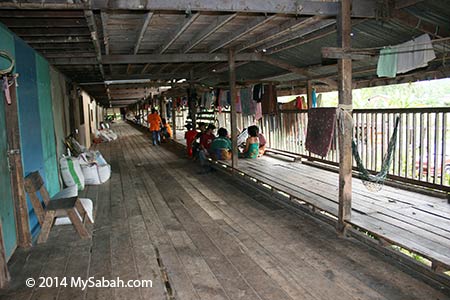
Pic: photos of “modernised” longhouse, which is more durable and offers bigger space. More livable but lack of cultural identity.
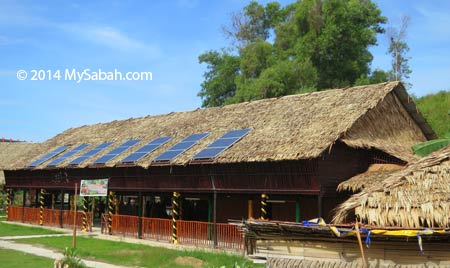
Pic: longhouse with solar panels (certified low-energy green building). This longhouse in KDCA Penampang costs about half a million Ringgit (≈US$157,000) to construct!
The Rungus
Longhouse is not the only cool thing about Rungus. Rungus is renowned weaver. They produce finely woven textiles, handicraft and beadwork which incorporate intricate traditional motif.
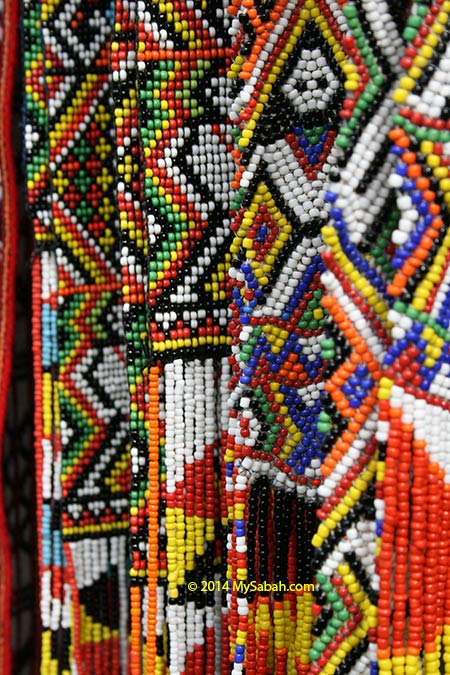
The motif design of Rungus is inspired by animals, plant and other things in their environment. Each piece takes 1 to 7 days to make, depend on its complexity. Some motif carries meaning such as good health.
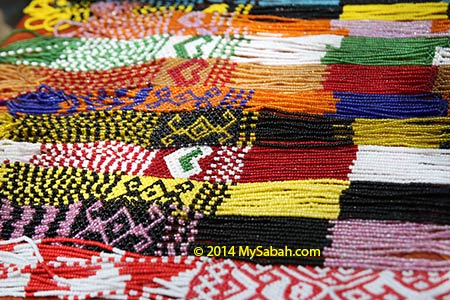
The handmade beadwork of Rungus is so beautiful and colorful that it is one of the most popular souvenirs tourists bring home. It’s also nice as an exotic accessory for lady dress. With prices start from only a few dollars, it’s quite affordable.
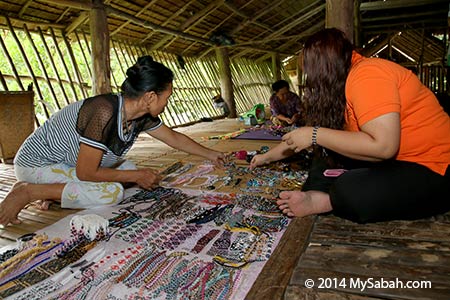
If you go to Kudat, I highly recommend you to buy some handicraft from the locals. In fact, most Rungus handicraft for sale in city shops are from them, but being priced higher by distributors.
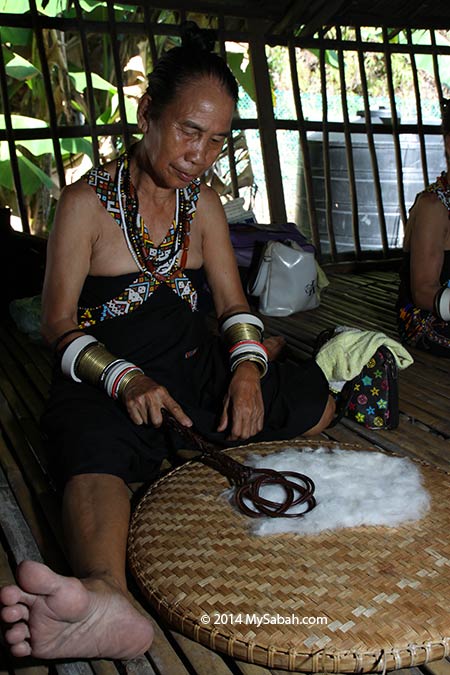
Pic: Rungus woman is also skillful in producing homespun cloth made from cotton (kapok)
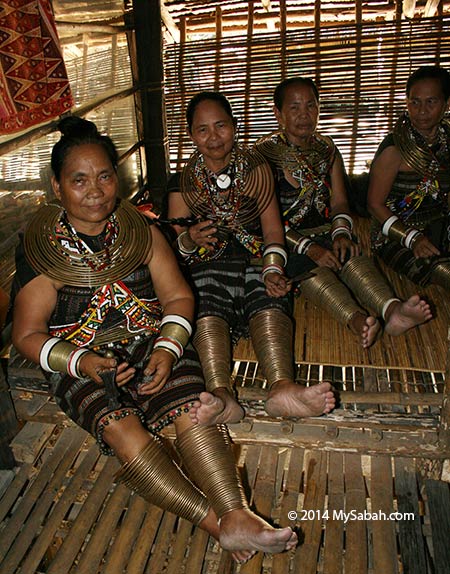
The traditional costume of Rungus is truly unique. I haven’t seen other Borneo tribes that share the similar traits. The photo above is the “most traditional” custome of Rungus women, who wear Ganggalung, disc of brass coil necklace of 40cm in diameter, and Lungkaki, the tightly coiled ornament covering the lower leg. Ganggalung and Lungkaki are seldom worn today. They told me that the brass outfit is heavy and make them lazy to move.
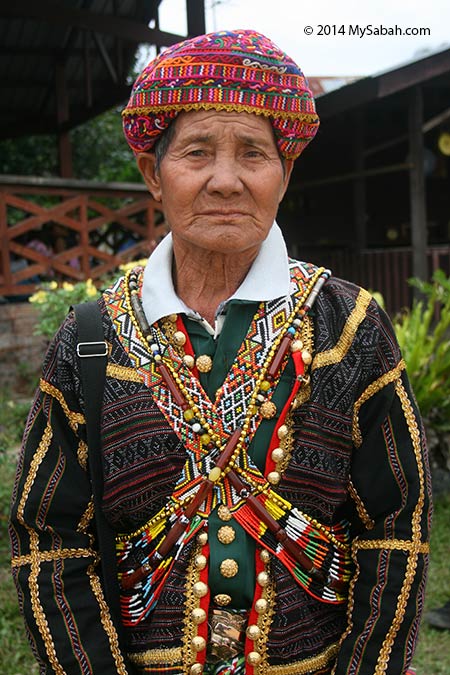
Pic: A Rungus man wearing colorful sash and a sigal, the traditional embroidered headgear. He looks serious but he is very friendly.
Staying in Longhouse
If you would like to experience staying in longhouse, you may visit Kampung Bavanggazo or Maranjak Longhouse Lodge in Matunggong, about 150 KM north of Kota Kinabalu city and 40 KM south of Kudat town (see Location Map). Both longhouses are only a few KM away from each other and their owners are brothers.
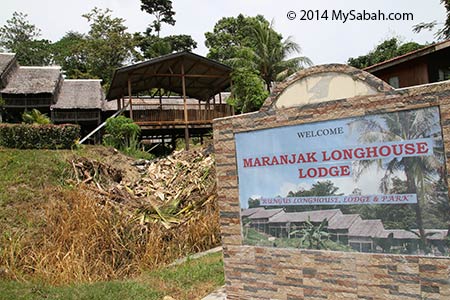
Their longhouse can host about 30 to 40 guests at a time. The accommodation fee is about RM60 – RM80 per night (≈US$19 – 25) and Online Booking is available. You also can sign up for some activities such as fishing, crab catching, hiking and tour around in Kudat.
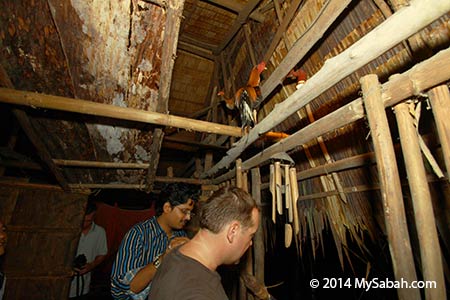
Lastly, mind your head when you visit a longhouse. Incoming! LOL
*Census 2000
**source: Sabah Traditional Ethnic Houses, published by Department of Museums Malaysia (ISBN: 978-967-9935-81-3)
Photos taken in Sabah, Malaysia Borneo
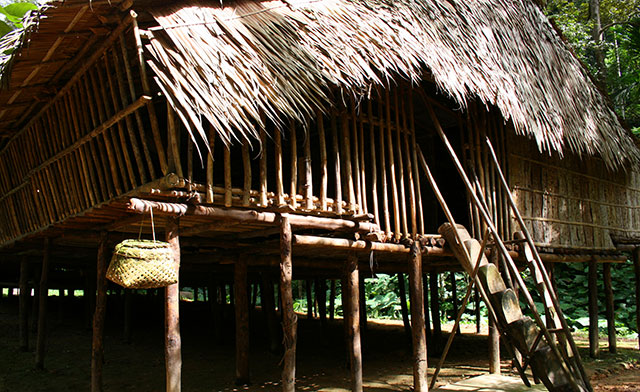



I’ve been to the Marajak Long house and it was beautiful. I think it was modified to suit for the needs of tourists but still it does not differ much for an original one. With so may holes on the walls as they were designed to be, I wonder how they could ever get the much-needed privacy. Any idea? I’ve been wondering 🙂
Hi Jipp, I don’t mind about the holes on the wall, as this is what longhouse looks like, and I enjoy being watched, just kidding. Even if they cover up the holes, you still can hear what happens next door. 😀 Well, that’s part of the experience.
Hi Murphy, great job. What a write up! Just to let you know that the Bidayuh tribe from Sarawak and Kalimantan Barat do wear almost similar copper/brass rings but not around the neck. I never knew about these Rungus’ adornments too. Here’s the link to our Youtube clip on the Sungkung Bidayuh copper ring ladies. In Sarawak there are six of such ladies remaining. Just to share with you.
Hi Bombastic Borneo, thanks for sharing your nice video. It’s really interesting to know that. This is a fading tradition. I only saw the Rungus women in brass rings once and so glad to capture that. I should have documented it with video too.